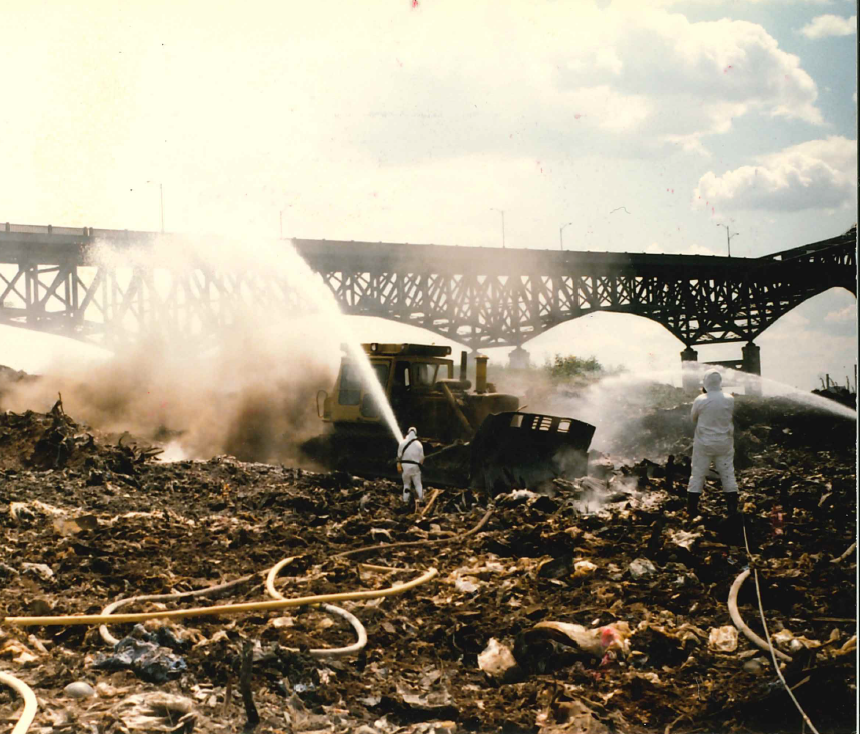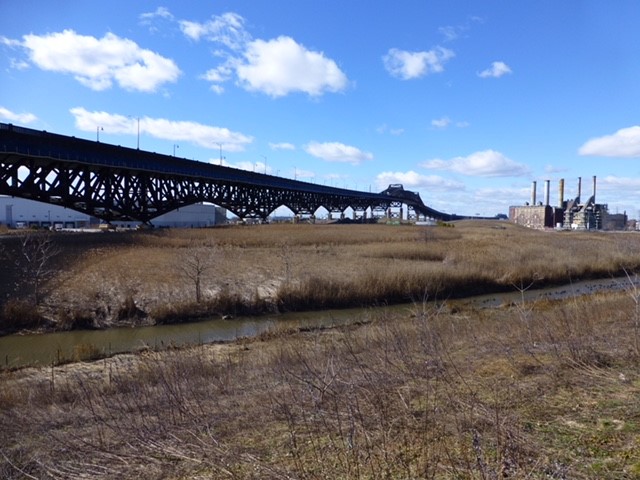|
|
US EPA, Office of Public Engagement, 1200 Pennsylvania Avenue NW, Washington, DC 20460 United States
Blognya Inyong, Berita Harian Anda ada Tips-Tips yang Keren dan Gadget Reviews Oke
|
|
0 comments Friday, June 29, 2018

EPA Recognizes Jersey City, N.J., Superfund Site for Excellence in Reuse
Contact: Elias Rodriguez, (212) 637-3664, rodriguez.elias@epa.gov
(New York, N.Y. – June 28, 2018) Today, U.S. Environmental Protection Agency (EPA) Regional Administrator Pete Lopez today presented New Jersey Department of Environmental Protection (NJDEP), Jersey City and Prologis, Inc. – the company responsible for the cleanup and reuse of the site – with the Excellence in Site Reuse Award. NJDEP Deputy Commissioner Debbie Mans, Jersey City Deputy Mayor Marcos Vigil and representatives from Prologis, Inc. accepted the Excellence in Site Reuse Award for work at the PJP Landfill Superfund site in Jersey City, N.J.
The award recognizes Superfund site partners who have collaborated with EPA to support redeveloping Superfund sites in ways that are beneficial to the community and compatible with the cleanup. The PJP Landfill Superfund site is home to a newly constructed warehouse and distribution center, continued commercial use, public open space and restored wetlands.
"This has truly been a collaborative effort between local, state and federal agencies and the community to turn this once environmentally compromised site into an economic and community asset," said EPA Regional Administrator Pete Lopez. "The Excellence in Reuse award underscores how Superfund cleanups translate into tangible benefits for local communities, businesses and an area's entire ecosystem. Redevelopment of this site will continue bringing economic, ecological and recreational benefits to the Jersey City community."
"This is truly an environmental success story, one in which a landfill that once was notorious for long-burning underground fires and exposed wastes has been reclaimed for productive commercial use," DEP Commissioner Catherine R. McCabe said. "We are proud to accept this award, which acknowledges the many years of hard work the DEP – in partnership with the EPA, Jersey City and Prologis – has dedicated to turning a major environmental problem for the city into a project that is creating jobs and economic development."
"The City is excited to be involved with the transformation of the once blighted landfill into a viable, mixed-use waterfront property for the public to enjoy," said Jersey City Deputy Mayor Marcos Vigil.
"When we acquired this former landfill back in 2008, we knew it would take a great deal of tenacity and teamwork to transform a site many thought could never be developed," said Prologis' Senior Vice President Steve Campbell. "The key to success was a public-private partnership that allowed Prologis to work closely with Waste Management Corporation, the EPA, the New Jersey Department of Environmental Protection, New Jersey local and state political leadership and, most importantly, the local community. The outcome has been positive for both the environment and the regional economy."


A past and present view of part of the PJP Landfill Superfund site beneath the Pulaski skyway, Jersey City, N.J., and future location of a community park. Photo credits: New Jersey Department of Environmental Protection (archival photo), Courtesy of EPA (cleaned-up, present day).

Today, the site has been redeveloped and includes a Prologis distribution center. (Photo Credit: Courtesy of Prologis)
From about 1970 to 1974, the PJP Landfill Company operated a commercial landfill at the site, accepting chemical and industrial waste. Landfill operations contaminated groundwater, soil and sediment with hazardous chemicals and for over a decade, between 1970 and 1985, the landfill had frequent subsurface fires. In 1983, EPA added the site to the National Priorities List.
NJDEP addressed subsurface fires and other immediate concerns in the mid 1980's by capping a 45-acre portion of the site. In addition, NJDEP excavated and re-compacted over one million cubic yards of contaminated materials. NJDEP also removed drums and capped about half of the landfill. When outside parties expressed interest in purchasing the site property for potential redevelopment, NJDEP and EPA redesigned the cap to accommodate redevelopment.
In March 2008, AMB Corporation purchased a portion of the site for a large warehouse. Jersey City purchased 32 acres of cleaned up land in 2010, with the goal to create green space and a park on its portion of the site – the Skyway Park. The park, currently in its planning phase, will address a community need for open space and waterfront access. In 2014, Prologis completed the Pulaski Distribution Center, a Leadership in Energy and Environmental Design (LEED)- certified warehouse for retail packaging and distribution operations.
Businesses on the site employ about 1,223 people, providing estimated annual employment income of nearly $53 million. In 2016, site properties generated $1.8 million in tax revenues, and had a total estimated property value of $24 million.
Remaining acreage at the site has been designated for wetlands and habitat restoration.
For a fact sheet about the PJP Landfill redevelopment, and for more Superfund redevelopment success stories, visit: www.epa.gov/superfund/pjp-landfill and https://www.epa.gov/superfund-redevelopment-initiative
Follow EPA Region 2 on Twitter at http://twitter.com/eparegion2 and visit our Facebook page, http://facebook.com/eparegion2.
18-047
0 comments Thursday, June 28, 2018
|
0 comments Wednesday, June 27, 2018
|

Contact: David Sternberg 215-814-5548 sternberg.david@epa.gov
EPA Outlines Expectations for Next Phase of Chesapeake Bay Restoration Effort
PHILADELPHIA (June 20, 2018) – Today, the U.S. Environmental Protection Agency (EPA) sent letters to Pennsylvania, New York, Delaware, Maryland, Virginia, West Virginia, and the District of Columbia outlining what the agency expects to see in state and local implementation plans for the third phase of the Chesapeake Bay Total Maximum Daily Load (TMDL).
"The Phase III Watershed Implementation Plans will provide clear roadmaps for how federal, state, and local partners will work together to achieve their Bay TMDL nitrogen, phosphorus, and sediment reduction goals," said EPA Regional Administrator Cosmo Servidio. "EPA worked hand in hand with the seven Bay jurisdictions in developing the expectations for these plans."
The expectations included in today's letters were developed to support the goal of having all the practices and controls in place by 2025 to achieve the nutrient and sediment reductions necessary to meet water quality standards in the Bay and its tidal tributaries. They also build on the jurisdictions' earlier Water Implementation Plan (WIP) strategies by:
These expectations also incorporate recent decisions made by the Chesapeake Bay Partnership Principals Staff Committee (PSC), which includes the seven Bay jurisdictions, EPA, and the Chesapeake Bay Commission.
To date, the states and the District of Columbia have made progress on their phase I and II goals, and that progress is having a measurable impact. For example, in 2017, scientists recorded the highest number of acres of underwater grasses ever seen in the watershed and the first time in the history of monitoring that total abundance surpassed 100,000 acres. In addition, over 40 percent of our tidal waters are now meeting water quality standards, which is the highest recorded in the history of the Chesapeake Bay Program.
Background
In December 2010, EPA established the Chesapeake Bay Total Maximum Daily Load (Bay TMDL). The Bay TMDL is the largest ever developed by EPA, encompassing a 64,000-square-mile watershed. The Bay TMDL identifies the necessary pollution reductions from major sources of nitrogen, phosphorus, and sediment across the Bay jurisdictions necessary to meet water quality standards.
Based on a 2009 baseline, the Bay TMDL calls for watershed-wide reductions of 25 percent for nitrogen, 24 percent for phosphorus, and 20 percent for sediment to meet these standards.
The Bay TMDL is designed to ensure that all pollution control measures needed to fully restore the Bay and its tidal rivers are in place by 2025. The Phase III WIPs will outline the jurisdictions' pollution reduction strategies for the time period from 2018-2025.
For more information, visit: https://www.epa.gov/chesapeake-bay-tmdl.
0 comments Wednesday, June 20, 2018

Contact: Roy Seneca seneca.roy@epa.gov, 215-814-5567
EPA awards $500,000 Supplemental Funding for Montgomery County Brownfields
(AMBLER, Pa.) June 19, 2018 – Today, the U.S. Environmental Protection Agency announced $500,000 in supplemental funding to Montgomery County, Pennsylvania to assist with the cleanup of contaminated brownfields properties.
"This funding will provide Montgomery County with resources to continue its cleanup work on contaminated properties throughout the county," said EPA Mid-Atlantic Regional Administrator Cosmo Servidio. "Returning these lands to beneficial reuse is the goal, and this grant will help the county reach that milestone at additional locations."
Montgomery County is one of 33 municipalities nationwide to receive a portion of the $15.7 million in supplemental funding for existing Revolving Loan Fund (RLF) grantees so they can carry out cleanup and redevelopment projects.
"The Redevelopment Authority and Montgomery County are appreciative of the financial and technical support provided by EPA in helping us return numerous brownfields sites to productive use," said John Nugent, Executive Director of the Montgomery County Redevelopment Authority. "Our collaborative work with EPA can be seen in projects where remediation has resulted in significant job creation, assisted with economic viability and supported the development of affordable housing."
Today's announcement took place at the former Ambler Boiler House property, a former industrial site that was cleaned up with a prior RLF grant and is now the Ambler Boiler House office building, a multi-tenant workplace where more than 300 people are employed.
Since 1999, EPA has provided Montgomery County with nearly $4 million in brownfields funding to assess, cleanup and spur redevelopment of brownfields sites. The most recent funding was used to remediate parking lots at the Boiler House office complex and the Ambler Crossings luxury apartments. Past brownfields funds have been used for sites in Pottstown, Upper Dublin and Abington Townships.
The Brownfields RLF program supports EPA's commitment to assist communities in addressing environmentally challenged properties and meet their local revitalization priorities. The funds help communities reuse vacant and abandoned properties and turn them into community assets such as housing, recreation and open space, health facilities, social services, transportation options, infrastructure and commerce opportunities.
RLFs specifically supply funding for loans and sub-grants to carry out cleanup activities at brownfields sites. These funds are provided to communities that have shown success in cleaning up and redeveloping brownfields sites.
A recent national study shows that cleaning up brownfields areas leads to residential property value increases of 5 - 15.2 percent within a 1.24-mile radius of the site. Another study analyzing data near 48 brownfields found that an estimated $29 to $97 million in additional tax revenue is generated for local governments in a single year after cleanup. This is two to seven times more than the $12.4 million EPA contributed to the cleanup of those brownfields.
More information on EPA's Brownfields program is available at: http://www.epa.gov/brownfields and a complete list of grantees is available at: https://www.epa.gov/brownfields/announcing-fy18-supplemental-funding-brownfields-revolving-loan-fund-grants.
0 comments Tuesday, June 19, 2018
|
0 comments Monday, June 11, 2018
|
0 comments Wednesday, June 6, 2018
Copyright © 2010 BLOGNYA INYONG | BERITA HARIAN | TIPS KEREN | GADGET REVIEWS
Theme Código Geek 2.0, Designed by Bahia Studio
Blogger Templates by Blog and Web